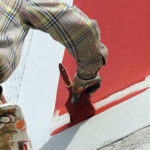Content
- 1 What is most often faked?
- 2 Counterfeiting Methods
- 3 How to protect yourself from buying a fake
You finished the repair, and after a month the tile in the bathroom began to fall off, the wallpaper sagged, a new tap leaked? You should not immediately blame yourself for “crooked hands” - you may be “lucky” to buy falsified building materials.
What is most often faked?
Fraudsters are primarily interested in goods for which there is an increased demand, and which are not difficult to fake. These include, first of all, adhesives, paints, cement, adhesive compositions for ceramic tiles, etc. Forgery of these materials brings dishonest dealers good profits, and buyers - problems and additional costs.

Counterfeiting Methods
There are many of them. The most harmless of them is this: a building mix of a well-known manufacturer in bags, say, 50 kg, is officially bought for itself. Similar bags are ordered at the printing house, but 10 times smaller, the mixture is packaged in 2-3-5 kilograms and sold with a good “fat”. But in this case, the buyer only overpays, the product remains quality.
The second, more common case - “merchants” buy inexpensive products: mortar, cement, glue from a little-known enterprise and put up in a “branded” container. Or even simpler - the top layer of paper is peeled off the bag and a fake copy of the packaging of a well-known brand is glued. The price, of course, is set as for the original.

Well, the most “neglected” case is the sale of mixtures, adhesives and paints of completely incomprehensible manufacturers and made according to a mysterious recipe in company packaging. In this case, some kind of quality of speech is not at all.
How to protect yourself from buying a fake
In order not to spend money in vain and make repairs again, it is strongly recommended that you pay attention to moments like this: all branded packages from reliable manufacturers consist of several layers of high-quality paper. Labels on packages are bright, clear, do not blur when the package gets wet. Sometimes businesses order embossed packaging. It costs more, but forging such packages is unprofitable and difficult.

To counteract fraud, many enterprises apply so-called thermograms to their products - elements that change color when exposed to heat (for example, if you touch them with your finger. Holograms are also applied, but they are not so reliable and scammers have long learned to fake them.
A novelty among anti-counterfeiting products is a zip tape. It is used in the manufacture of cigarette packs, tea and chewing gum - a tear-off red ribbon.
Today, some building materials are packed using zip tape. This is not only convenient - equipment for the production of tape is very expensive, forging products becomes unprofitable, which provides a high degree of protection against falsification.

And finally - buy building materials in large reputable retail outlets, always keep receipts in case of complaints about the quality of building materials.
-
 What roof will have to be repaired after 5 years of operation
What roof will have to be repaired after 5 years of operation
-
 What many people don’t like
What many people don’t like
-
 What materials parquet does not last long
What materials parquet does not last long
-
 Why tape fum is an unreliable way, the best options
Why tape fum is an unreliable way, the best options
-
 What you should not make a roof in the north
What you should not make a roof in the north
-
 What finishing materials can you save on
What finishing materials can you save on
-
 What pipes for plumbing do not live long
What pipes for plumbing do not live long
-
 Why you should not replace the ondulin brand horse with a metal one
Why you should not replace the ondulin brand horse with a metal one
-
 What pipes are better not to mount inside the wall
What pipes are better not to mount inside the wall
-
 What are the hidden flaws in aerated concrete
What are the hidden flaws in aerated concrete
-
 Linkrust: characteristics and technology of gluing
Linkrust: characteristics and technology of gluing
-
 What are the advantages of relin material
What are the advantages of relin material
New publications are published daily on our channel in Yandex. Zen
Go to Yandex. Zen


